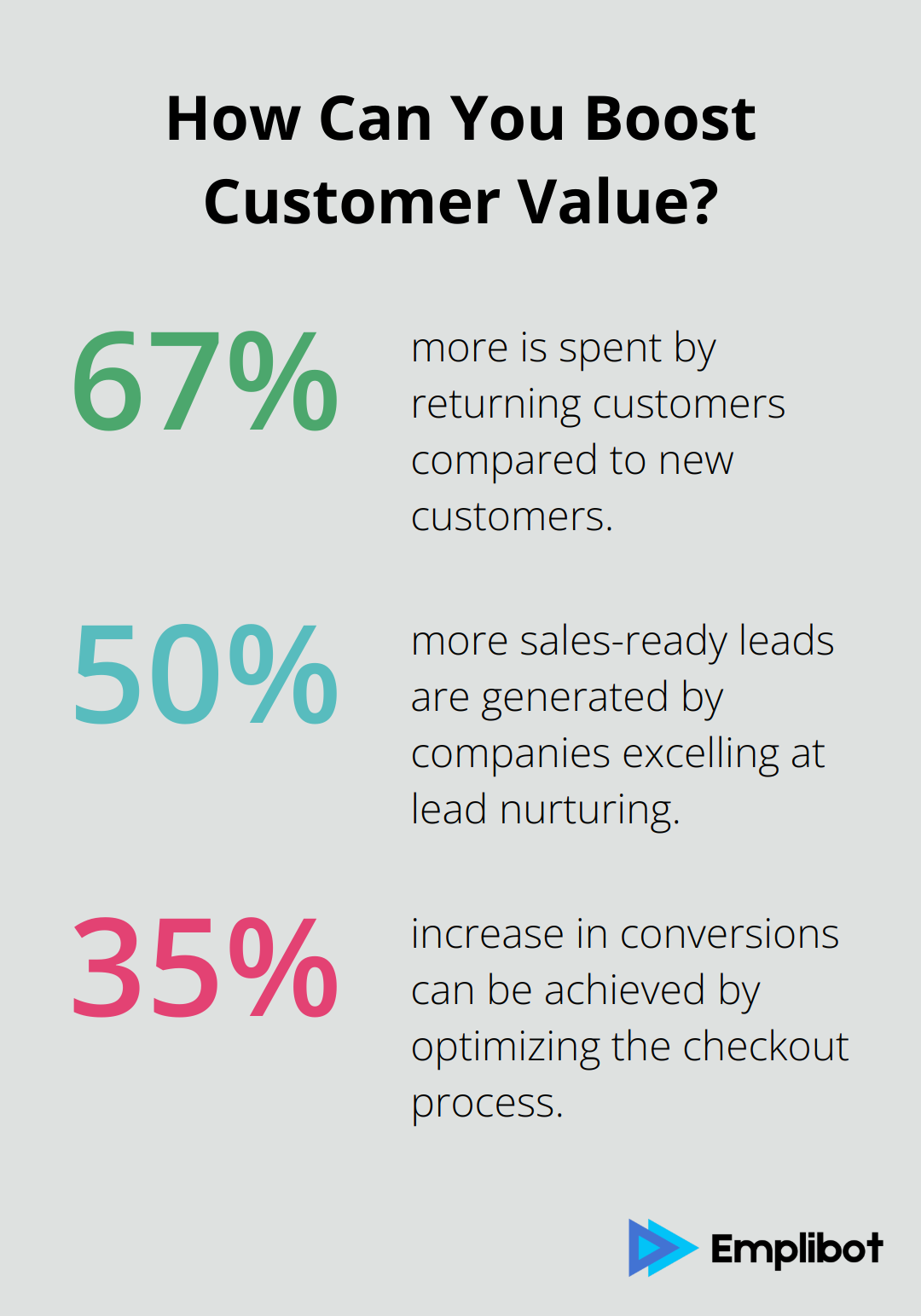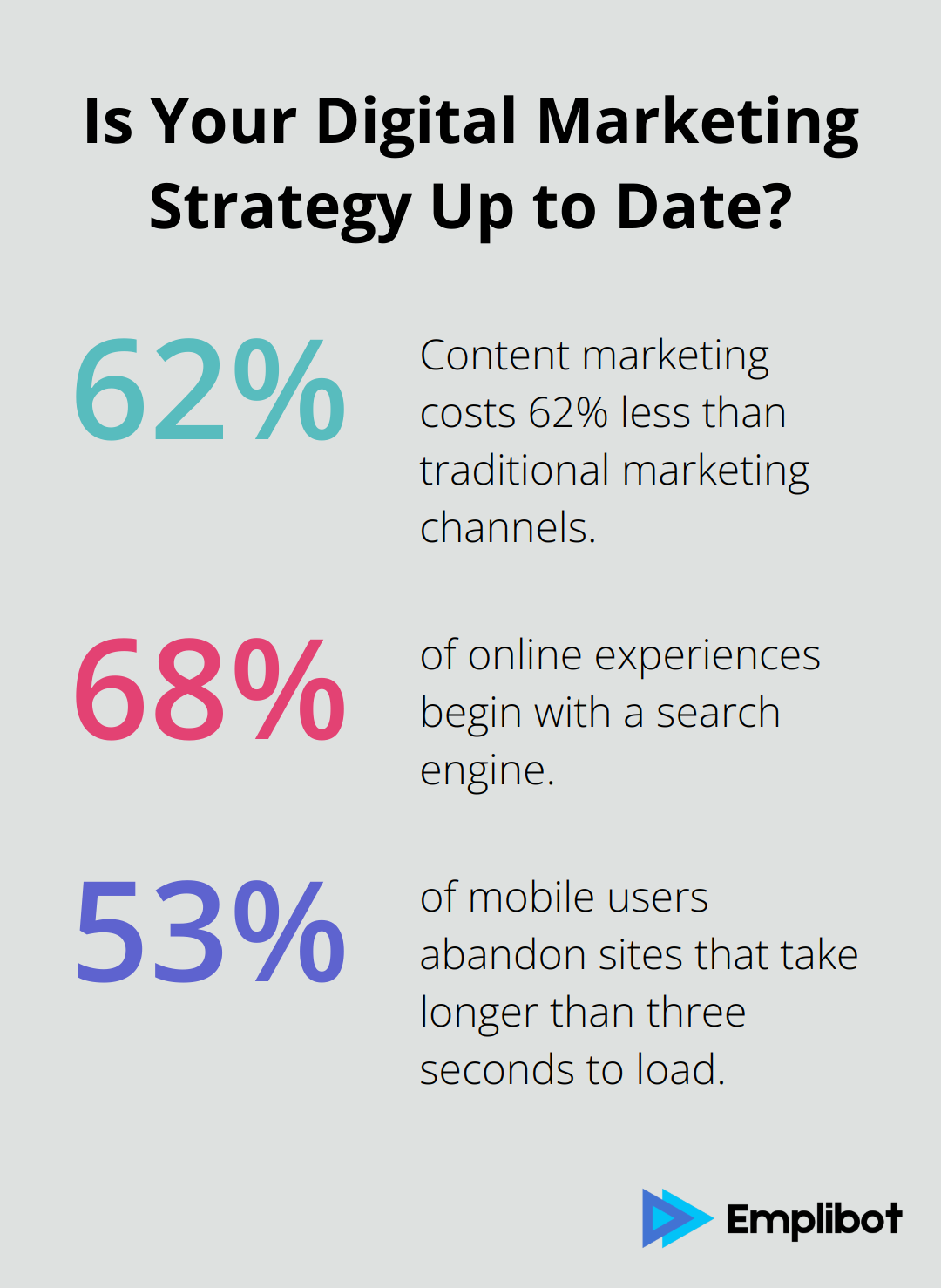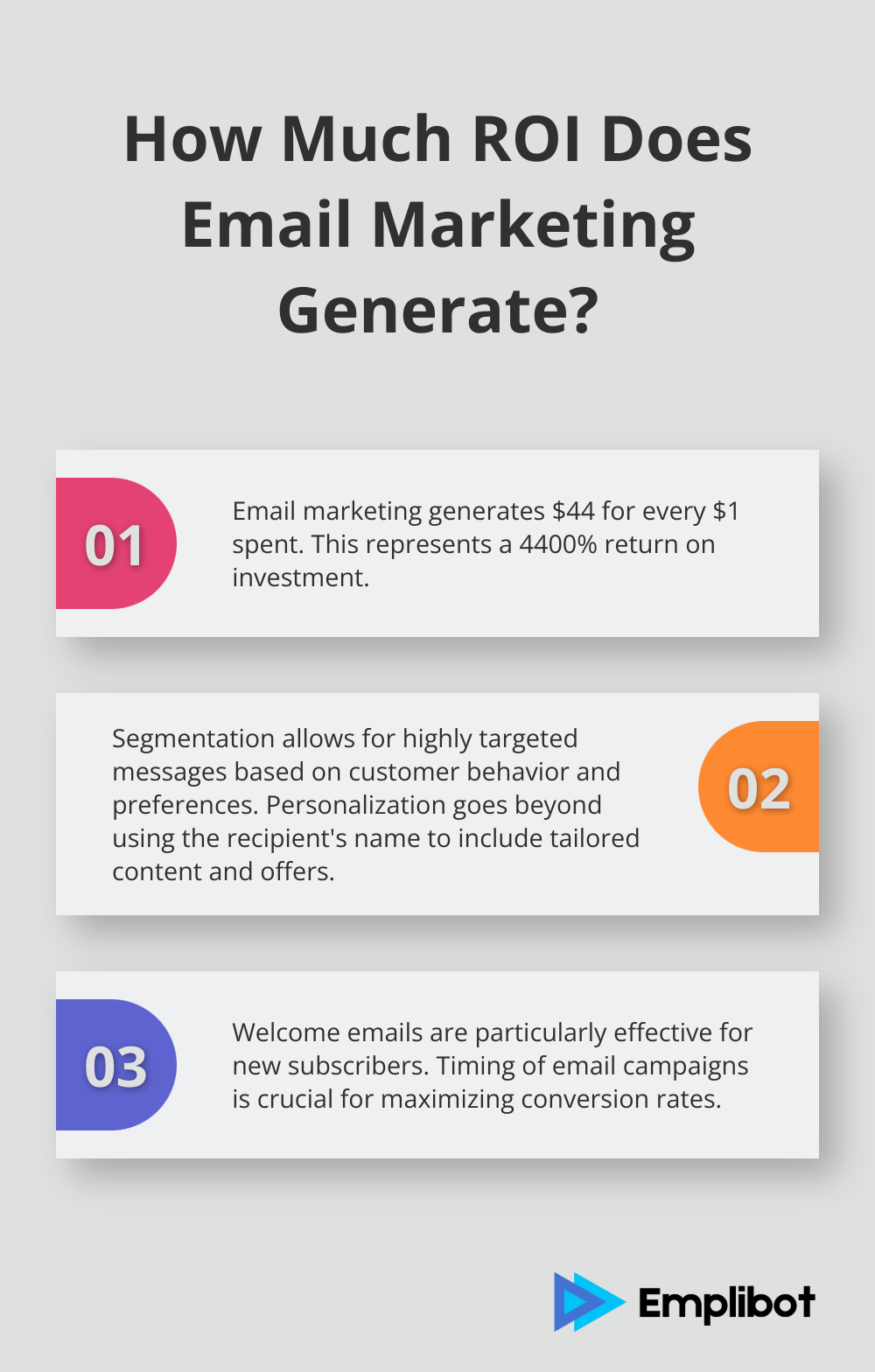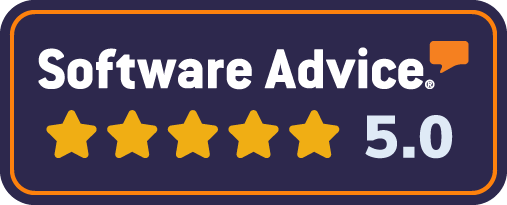Ecommerce businesses face fierce competition in today’s digital marketplace. To succeed, they need a well-crafted ecommerce marketing funnel that guides potential customers from awareness to purchase.
At Emplibot, we’ve seen firsthand how a strategic approach to each stage of the funnel can dramatically boost online sales. This blog post will explore effective tactics for optimizing your funnel and driving revenue growth.
Contents
ToggleWhat Is an Ecommerce Marketing Funnel?
The Power of Strategic Customer Journey Mapping
An ecommerce marketing funnel is a strategic model that maps out the customer journey from initial brand awareness to purchase and beyond. It’s not just a theoretical concept – it’s a practical tool that can significantly impact your bottom line. A study by Forrester Research reveals that companies which excel at lead nurturing generate 50% more sales-ready leads at 33% lower cost.
The Four Stages of the Funnel
The ecommerce marketing funnel typically consists of four stages: Awareness, Consideration, Conversion, and Retention. Each stage requires specific strategies to move potential customers closer to a purchase decision.
- Awareness: This is where you grab attention. Social media ads, content marketing, and SEO are key players here. Beauty brand Glossier (for example) attributes much of its rapid growth to its strong social media presence, particularly on Instagram.
- Consideration: At this stage, potential customers evaluate your products. Detailed product descriptions, comparison guides, and customer reviews are essential. Amazon excels here with its comprehensive product pages and customer Q&A sections.
- Conversion: This is where the sale happens. A smooth checkout process is essential. Shopify reports that optimizing the checkout process can increase conversions by up to 35%.
- Retention: Keep customers coming back. Email marketing and loyalty programs are effective tools. Sephora’s Beauty Insider program (as an illustration) boasts over 25 million loyal members.
Tracking Success: Key Metrics for Each Stage
To optimize your funnel, you need to track the right metrics at each stage. Here are some key performance indicators (KPIs) to monitor:
Awareness Metrics
Track website traffic, social media engagement, and brand mention volume. Tools like Google Analytics and Brandwatch can help here.
Consideration Metrics
Look at metrics like time on site, pages per session, and email open rates. HubSpot found that segmented email campaigns can lead to a 760% increase in revenue.
Conversion Metrics
Focus on conversion rate, average order value, and cart abandonment rate. The global average cart abandonment rate is 69.8%, according to Baymard Institute.
Retention Metrics
Monitor customer lifetime value, repeat purchase rate, and churn rate. Adobe reports that returning customers spend 67% more than new customers.
Optimizing Your Funnel with the Right Tools
While these metrics are important, collecting and analyzing them can consume time. This is where marketing automation comes in handy. It not only helps create engaging content for each stage of the funnel but also assists in distributing it across various platforms, saving you time and resources.

Your ecommerce marketing funnel isn’t set in stone. It should evolve based on data and customer behavior. Regular review of your metrics, testing of new strategies, and refinement of your approach will maximize your online sales potential. In the next section, we’ll explore effective strategies for the top of the funnel to capture attention and drive awareness.
How to Capture Attention in the Digital Marketplace
Harness the Power of Content Marketing
Content marketing stands as one of the most effective ways to attract potential customers. Content marketing costs 62% less than traditional marketing channels, and of these leads, they are 6 times as likely to convert. Create valuable, informative content that addresses your target audience’s pain points and questions.

For instance, if you sell fitness equipment, produce blog posts about workout routines, nutrition tips, and the benefits of regular exercise. This approach attracts potential customers and positions your brand as an authority in your niche.
Optimize for Search Engines
Creating great content is essential, but ensuring its discoverability is equally important. Implement solid SEO practices to improve your visibility in search engine results. Research indicates that 68% of online experiences begin with a search engine, making SEO a critical component of your awareness strategy.
Use tools like Google’s Keyword Planner or SEMrush to identify relevant keywords with high search volume and low competition. Incorporate these keywords naturally into your content, meta descriptions, and page titles. Focus on technical SEO aspects like site speed and mobile optimization – Google reports that 53% of mobile users abandon sites that take longer than three seconds to load.
Leverage Social Media and Influencer Partnerships
Social media platforms offer unparalleled opportunities to reach and engage with your target audience. According to Statista, 4.48 billion active social media users exist worldwide as of 2021 (a massive potential audience for your brand).
Tailor your content to each platform’s unique characteristics. Use eye-catching visuals on Instagram, share industry insights on LinkedIn, and engage in conversations on Twitter. Consistency matters – brands that post on social media at least once a day gain more followers and increase engagement.
Influencer partnerships can amplify your reach. A study by Tomoson found that businesses make $6.50 for every $1 spent on influencer marketing. Identify influencers whose audience aligns with your target market and collaborate on content that showcases your products authentically.
Implement Strategic Paid Advertising
While organic reach provides value, paid advertising can give your awareness efforts a significant boost. Platforms like Google Ads and Facebook Ads offer sophisticated targeting options to reach your ideal customers.
On Google Ads, focus on both search and display networks. Search ads capture high-intent users actively looking for products like yours, while display ads build brand awareness among broader audiences. Facebook’s detailed targeting options allow you to reach users based on demographics, interests, and behaviors.
Start with a small budget, test different ad formats and targeting options, and scale up what works best. According to WordStream, the average click-through rate for Facebook ads across all industries is 0.90%, while for Google Ads it’s 3.17% for search and 0.46% for display.
As you implement these top-of-funnel strategies to capture attention, it’s important to consider how you’ll nurture these leads through the next stages of your ecommerce marketing funnel. Let’s explore effective tactics for the middle and bottom of the funnel to convert this newfound attention into sales.
AI in sales can also play a crucial role in capturing attention and boosting conversion rates. For example, an AI marketing bot can deliver personalized product recommendations, potentially increasing conversion rates by 30% for e-commerce companies.
How to Convert Leads into Customers
Craft Compelling Email Campaigns
Email marketing proves to be one of the most effective tools for converting leads. Campaign Monitor reports that email marketing generates $44 for every $1 spent (an astounding 4400% ROI). However, not all email campaigns yield equal results.

Segment your email list based on customer behavior, preferences, and purchase history. This strategy allows you to send highly targeted messages that resonate with each group. For example, a clothing retailer might send different emails to customers interested in men’s wear versus those who typically browse women’s accessories.
Personalization is key. Go beyond just using the recipient’s name – tailor the content, product recommendations, and offers based on their past interactions with your brand.
Timing matters too. Welcome emails can be particularly effective for introducing new subscribers to your best products or offers.
Implement Smart Product Recommendations
Personalized product recommendations can significantly boost your average order value. If done successfully, your website will edge ahead of your competitors, increase average order values, and ultimately drive more revenue.
Use data from browsing history, past purchases, and similar customer profiles to suggest relevant products. Display these recommendations on product pages, in shopping carts, and in follow-up emails.
AI-powered content creation can help you craft compelling product descriptions and recommendations that resonate with your audience (potentially increasing conversion rates by up to 30%).
Recover Abandoned Carts
Cart abandonment presents a significant issue in ecommerce. However, this also presents a massive opportunity for recovery.
Implement a series of abandoned cart emails. Send the first email within an hour of abandonment, as these emails can have high open rates and conversion rates.
Make these emails personal and engaging. Remind customers of what they left behind, address common objections, and consider offering an incentive to complete the purchase.
Leverage Social Proof
Social proof can motivate on-the-fence customers.
Display customer reviews prominently on your product pages. Encourage satisfied customers to leave reviews by sending follow-up emails after purchase. Consider implementing a review management system to streamline this process.
User-generated content, such as customer photos with your products, can also prove highly effective.
Optimize Your Conversion Process
Try to simplify your checkout process. Remove unnecessary fields and offer guest checkout options. A streamlined process can reduce cart abandonment rates and increase conversions.
Implement trust signals throughout your site. Display security badges, especially on checkout pages, to reassure customers about the safety of their information.
Offer multiple payment options to cater to different customer preferences. Include popular methods like credit cards, PayPal, and digital wallets to reduce friction at the point of purchase.
Conversion rate optimization strategies, when combined with AI tools, can transform your website into a conversion-generating powerhouse.
Final Thoughts
An effective ecommerce marketing funnel guides potential customers from awareness to purchase and beyond. Businesses must implement targeted strategies at each stage to drive online sales and build lasting customer relationships. Content marketing, SEO optimization, and social media engagement capture attention, while email campaigns, personalized recommendations, and abandoned cart recovery convert leads into customers.

The ecommerce marketing funnel requires continuous optimization based on data and customer feedback for long-term success. Regular analysis of metrics, testing of new strategies, and refinement of approaches maximize online sales potential. Social proof, streamlined conversion processes, and excellent customer service build trust and encourage purchases throughout the funnel.
Emplibot offers a comprehensive solution for businesses to streamline their content creation and distribution processes. It automates tasks like keyword research, content generation, and SEO optimization, allowing businesses to focus on strategy and growth. This powerful tool ensures a consistent flow of high-quality, engaging content across multiple platforms, enhancing the effectiveness of the ecommerce marketing funnel.






![Will AI Kill Blogging? [What You Need To Do Today]](https://wp.emplibot.com/wp-content/uploads/emplibot/ai-kills-blogging-1751008068-768x456.jpeg)



